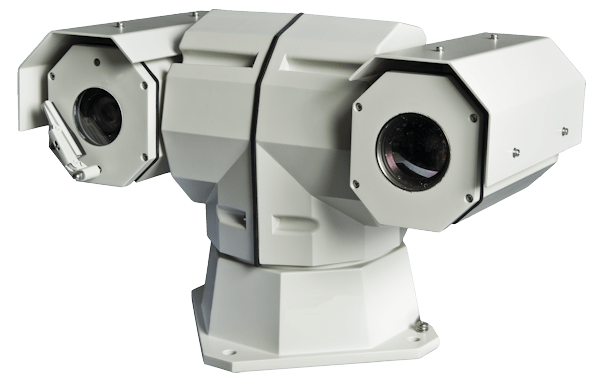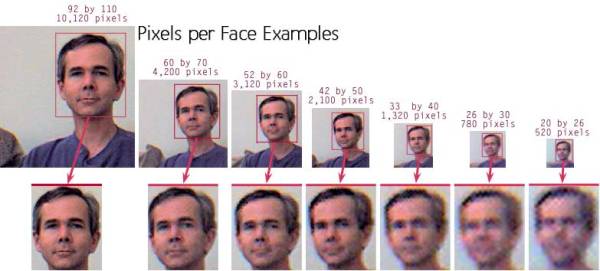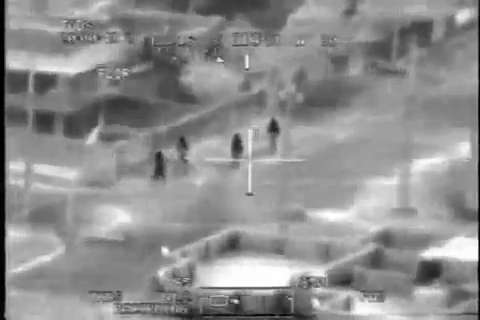
How far away can we see things using a long range PTZ camera? Obviously, we can see the moon which is 238,900 miles away, but of course we would need a powerful telescope to see the small craters. We can see people in a crowd, but when we want to identify their face, it gets a lot harder. The distance is determined by what detail we need to see.
Do you want to be able to detect a vehicle moving, or identify the person driving the vehicle? The objective will determine the type of IP camera system you will need. In general the distance is determined by the lens, the type of camera (thermal camera or optical camera), the camera resolution, and sometimes the IR illuminator available. This article describes how we can specify the IP camera system required for long distance viewing.
What detail do you need?
The detail we see depends on the number of pixels across the object we are viewing. To get a better idea of how many pixels are required take a look at the following picture:

As you can see as the more pixels the clearer the face will be. First determine your objectives. There is a difference between detection, recognition and identification of an object.
Detection of a Person or Vehicle
Detection is defined as seeing something (probably moving) in a field of view. We may have some idea what it is based on the size and place we are viewing. For example, we may be looking at a road, and when we see something moving assume that it is a vehicle. Detection requires a minimum of pixels across the target or object. If it’s moving you require less than if it is stationary.
There are thermal imaging cameras and long range optical IP cameras. Thermal detection is different than optical recognition because different image information is displayed.
It is estimated that thermal detection can be made at about 1.5 to 2 pixels across the target. This is especially true when the object is moving. Since the thermal image also displays a heat signature, it can make it easier to detect a person or hot vehicle.
Optical cameras use different detection criteria based on day or nighttime operation. During the day the image is clearer and includes color that can help with detection. We estimate that during the day, the optical camera can detect a person when there are about 6 pixels vertical pixels across the person. Note that we can detect a vehicle further away simply because it is larger than a person. At night the camera switches to gray-scale, and we usually use an illuminator. The range of the illuminator then becomes an important factor in detection distance. Since the image is nosier and doesn’t include color information, we estimate we will need about 9 vertical pixels across the target.
Recognition of a Vehicle

This is a general term that has different meanings depending on who you talk to. In the early days of thermal imaging, recognition was defined as the point where you could determine what type of vehicle was seen. With enough pixels across the target you can determine if the object is a person or a truck. “Recognition” was not usually used to determine what person was approaching.
A thermal imaging system requires about 8 – 10 pixels across the target to provide recognition.
Optical system recognition can vary depending on conditions. We estimate that 10 – 15 pixels across the target will provide a good chance of recognizing the object.
Identification of Vehicle or Person
This term “identification” is defined differently depending on who you talk to. For example, military organizations would like to see enough resolution (from a thermal camera) so they determine if the vehicle approaching is a M1-Abrams tank or a T-72. In the security world we talk about identifying a person’s face.
Vehicle: Thermal cameras are estimated to require 11 – 16 pixels across the target for identification. Optical cameras may require about 20 to 25 pixels across the target.
Person: In the security world we use the term “identification” to determine who a person is. We would like enough resolution to know that the person robbing the cash register is Tom and not Bob. This can also vary depending on whether we know the person and can identify them not only by their facial features but also by clothes they are wearing and how they walk. If we don’t know them and need to compare the video to a picture (forensic) we need better resolution. In optical systems we use about 40 pixels across the face for identifying someone we know and about 80 pixels across the face for forensic identification.
Determining the Lens we need
Now we can determine the lens angle we need using some trigonometry.

The “hypotenuse” is the distance to the target. The “opposite” is ½ the field of view. “X” is the ½ the angle of the lens we need.
Once we know how far away we would like to see, we can then determine the resolution required to see exactly what we want. We can select the right lens for detection, recognition, or identification.
For more details about using trigonometry to calculate the right lens take a look at our other article, Calculating What You Can See with Your IP Camera.
Lens for Detection
To detect a person we need about 9 vertical pixels. If a person is 5’ 7”, then we have a total of 67” across the person. Convert this to pixels per inch. 9 pixels/67” = 0.1343 pixels/inch. This is equal to 1.6 pixels/ft.

If we use a 2 megapixel sensor we have 1920 x 1080 pixels. The vertical field of view is 675 ft. We usually use the horizontal pixels since the lens angle is provided in horizontal. In this case the horizontal field of view is 1920 / 1.6 pixels/ft. = 1200 ft.
If we want to detect something that’s 2 miles away (10560 ft), and the opposite side is the ½ maximum field of view we calculated above (600 ft.), then the angle is 3.26 x 2 = 6.52 degrees. We will need a zoom lens that allows us to reach this angle (or magnification). We will need about a 100 mm zoom lens.
Lens for Recognition
To recognize a vehicle, we need about 10 – 15 pixels across the target. Let’s use 15 pixels across the target. To convert to pixels/ft. we need to estimate the size of the target. Let’s say we want to detect a person (which is smaller than a vehicle). Again the person is 67” tall, so we need 15/67 = 0.224 pixels/inch or about 2.7 inches/ft.
Using the 2 megapixel camera we get 1920/2.7 = 711 ft. for the field of view. Using our trig calculator the lens angle required at 10560 ft. away is 1.93 x 2 = 3.86 degrees horizontal angle. So the lens we select requires a zoom capability that will reach the angle. The lens we select will depend on the sensor size, but we probably need about a 140 mm lens.
Lens for identification
To identify the type of vehicle, we need a lot less pixels so we can use a wider angle lens. To identify a person’s face (who we know), we need about 40 pixels across the face. Here are the details of how to calculate the right lens for identifying a person’s face using a 2 megapixel IP camera.
Facial Identification: Let’s estimate a person’s face to be 6 inches wide or about 40pixels/6 inches = 6.7 pixels / inch or 80 pixels / ft. These are rough calculations and can vary depending on the type of camera and the lighting conditions.
The field of view using the 1920 x 1080 camera is calculated as 24 ft. The lens angle required is less than 0.1 X 2 = 0.2 degrees. This requires a very long range 2000 mm lens.
For more information about selecting the right IP camera system please contact Kintronics at 914-944-3425.